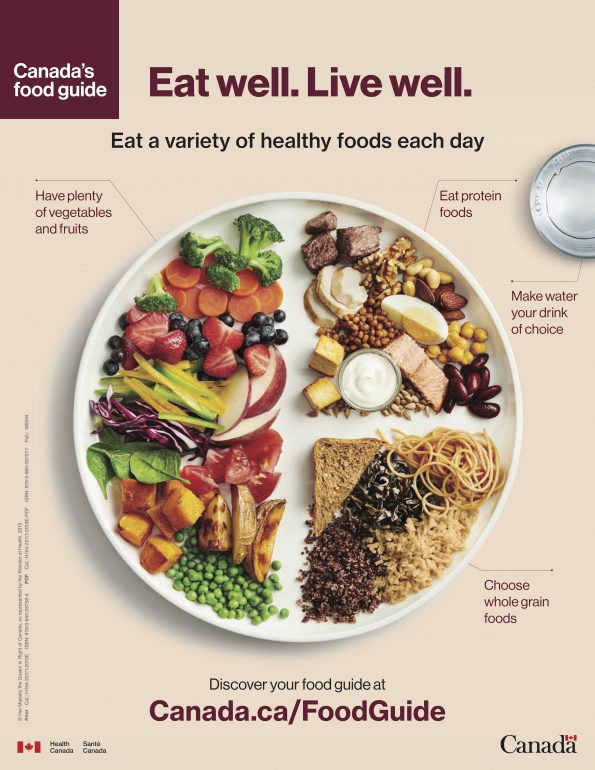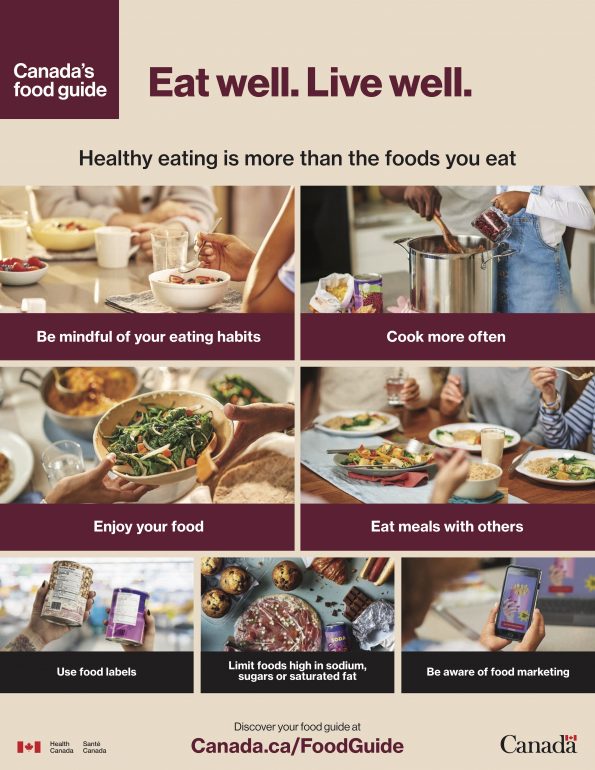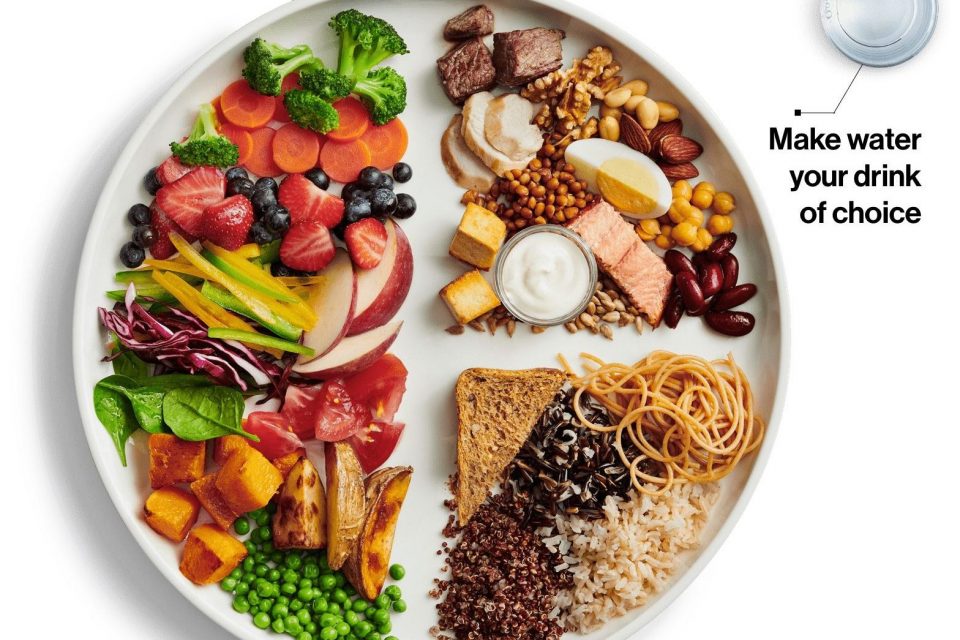A week ago, Health Canada released its first update to its Food Guide in 11 years. The new guide takes a much simpler approach, eschewing its prescriptive past, confusing serving information, and nutrient focused messaging. Instead, the new version focuses on whole foods, decreasing highly processed and prepared foods, and choosing more plant-based sources of protein. The new guide is based on the most recent scientific research and FINALLY strives to cut out industry’s influence on its dietary recommendations. The major theme of the new food guide is (delightfully), quality over quantity, something that dietitians (including myself) have been advocating about for years.

 Above you can see the new food guide, which is in the form of a “Healthy Plate”; no more servings or serving sizes. The classic rainbow of computer-generated images has been replaced with photos of real foods and how they should fit into your diet. Overall, I have to say I am quite impressed with the direction that Health Canada has taken with the update. However, there are some things that I like more than others….so I’ll go over out what I like and what I think could have been done better.
Above you can see the new food guide, which is in the form of a “Healthy Plate”; no more servings or serving sizes. The classic rainbow of computer-generated images has been replaced with photos of real foods and how they should fit into your diet. Overall, I have to say I am quite impressed with the direction that Health Canada has taken with the update. However, there are some things that I like more than others….so I’ll go over out what I like and what I think could have been done better.
What I like the most…
The biggest positive to me is the messaging around FOOD (which you may think duh it’s a “Food Guide”…), but the previous iterations of the guide have viewed food as simply a vehicle for nutrients – with the many cultural, social, and environmental factors laid to the wayside. The new food guide looks to correct this mistake, instead of quantifying food down to its basic nutrients, it focuses on getting back to the basics of cooking, eating and enjoying our food with others. This approach makes much more sense as we eat food NOT nutrients. The guide takes the focus on food to a new level, by incorporating mindfulness and the enjoyment of eating in its messaging. These are very important concepts that encapsulate the act of eating and are central to creating healthy habits and evaluating our own behaviour. The recommendations take into account the multiple meanings of food and help promote a more complete picture of the role that food and eating play in our lives. As I mentioned in my previous post, what we really should be focusing on is rekindling our relationship with cooking, and consuming more minimally processed foods vs. the quick convenience of prepared foods.
Another major positive for me is the hard line that Health Canada has taken with industry. I have to admit, that I had very little faith that the new recommendations would be as evidenced based as they are, without significant industry bias. Ever since the inaugural food guide in 1942, industry has been a part of its creation and has had the ability to influence recommendations in favour of its products (ie. recommending more milk, beef, wheat, etc.). With industry having influence on recommendations, the food guide was not only concerned with the health of Canadians, but also the wallets of these food companies. By finally cutting out industry, we are now able to have published guidelines which are based on sound scientific research without the self-serving influence of industry.
Focusing on the latest scientific research on healthy eating provides us with some much-needed changes to the recommendations, most notably:
– Emphasis on more plant-based sources of protein
– Emphasis on water for hydration (ie. juice no longer = fruit)
– No more low-fat advice, instead increasing unsaturated fats
– Emphasis on reducing highly processed and prepared foods
– Decreased emphasis on dairy products
These changes align with what the current research on nutrition and disease states. Studies have shown that people who eat more fruits and vegetables, consume more plant-based protein and cook more of their meals are healthier, live longer and have less chronic disease. Obviously, there are some considerable variables at play when it comes to health and it is not simply due to eating more carrots. Most times people who eat more vegetables are also more likely to exercise, have a higher incomes and are less likely to have substance abuse issues, but even when these variables are controlled for, consuming a mostly plant-based diet is still highly correlated with better health outcomes.
What could be better….
1. Still a notable lack of diversity – Canada is a very culturally diverse nation, with many different ethnicities and demographics, but the foods displayed on the plate diagram still represent a modern Eurocentric type of eating. The previous iterations of the guide have been translated into multiple languages, with different food recommendations for different ethnic groups and cultures, and separate recommendations for indigenous peoples in Canada. These previous inclusions are noticeably missing from the new update, and I sincerely hope this is addressed with changes soon, whether it’s further culturally-specific plate diagrams or separate documents altogether.
2. Food Accessibility – With the recommendations changing to recommend more fruits and vegetables, and more sources of plant-based protein the guidelines can make eating healthy less accessible for some populations, most notably low income populations. Increasing consumption of fruits and vegetables can be more costly for low income families, especially where nutrition knowledge and cooking skills are limited. There are many vegetables that are less expensive (e.g. carrots, onions, potatoes, apples, bananas, frozen or canned vegetables, etc.) but they usually require higher levels of food literacy to purchase, prepare and cook properly. Plant-based protein options can be less expensive than meat, but their preparation can require more advanced cooking skills and lengthy cooking processes that require access to cooking facilities. Accessibility isn’t always about the price and availability at the store, but also the knowledge, skills and facilities necessary to prepare the food. Health Canada does mention the importance of cooking skills, but I think that they could have done a better job at making the recommendations more realistic for a large part of the population that has limitations on financial resources, food literacy and cooking facilities.
3. Starchy vegetables still with the other vegetables – This may be a small thing, but I don’t like how the starchy vegetables (e.g. potatoes, sweet potatoes, corn, etc.) are still in the vegetable group and not paired with the grains, similar to how they are organized on the Diabetic Food Guide. These vegetables (while still very healthy!) contain higher amounts of carbohydrate and are metabolized similar to grain products when they are digested. This is only an issue if people are choosing these starchy vegetables instead of more nutrient dense options, and can easily be cleared up with a quick conversation.
4. Still no snacks? – The recommendations seem to be geared more towards meals, with only a few mentions of snacks in the accompanying messages. Snacks are a staple in most people’s diets and a little more information on creating healthy snacks (and incorporating some protein foods??) could have gone a long way to help ease understanding. [EDIT: On a deeper dive into the attached resources I found a page I missed entitled “Healthy snacks” check it out here.]
5. Not available in print – Lastly, Health Canada has mentioned they will not be providing printed copies of the food guide for this version. Their reasoning is that they want to create a more immersive / informative environment online, which I understand, but at the same time see many clients who do not have access to a computer. This may not be a major issue for some people, but for someone like me who could use the food guide as a teaching tool, it could come in quite handy. I sincerely hope they reconsider their position on offering a print version.
Overall, the new food guide is a major leap forward for Canada’s healthy eating recommendations. Health Canada will be releasing more documents based on the recommendations to be used to help form new healthy eating policies and educational programs. I think the foundational principles of the new guide are excellent and will help to create much more change on the policy side and inform a new generation of children with a more food focused approach to healthy eating. No guide will ever be perfect, or be appropriate for every culture, ethnicity or demographic, and I don’t think that can be expected. However, I hope Health Canada has the flexibility to make changes and updates over the life of the guide to make it relevant / appropriate for as many Canadians as possible. The newest version of the food guide updates it to 2019, where it has finally progressed to a point where we can stop whining and apologizing for its existence, and actually use it as legitimate tool to help make healthier decisions around food and eating.
-J

0 comments on “Quality over Quantity or: How I Learned to Stop Whining and (Mostly) Love the Food Guide.”Add yours →